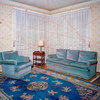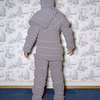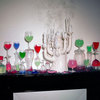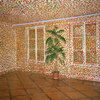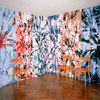A Conversation with Matthieu Lavanchy
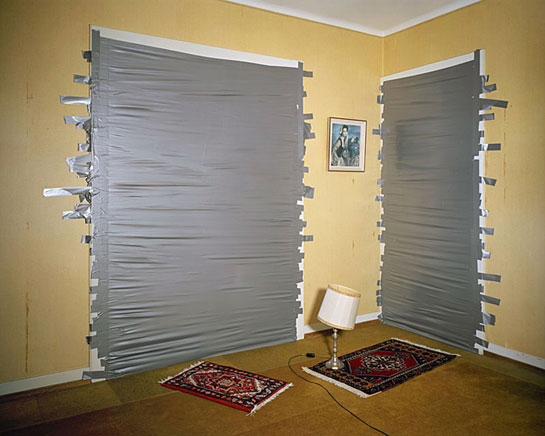
Matthieu Lavanchy is one of the two winners of this year’s Hyères Photography Festival. In this conversation, Matthieu and I talk about the background of his work.
Jörg Colberg: An integral part of your work involves constructing environments so that you can take photographs of them. So I’m wondering, are you a sculptor taking photographs, or are you a photographer using things you build as props?
Matthieu Lavanchy: I would say I’m a photographer using things I build as props. For me, it is not just about documenting something I created. The photographic aspects - the context, the light, the perspectives, the angle - are an integral part of the overall impact and meaning of my work. In my images, I try to get all the elements of a calculated set-up to work together to form a narrative and a sense-generating whole. And photography is a key part of this process.
JC: How did you develop this interest in producing those elaborate sets? Did you start out as a “straight” photographer and then found yourself interested in staging situations? How did you get there?
ML: Yes, I used to do a lot of landscape and architecture photography. I had this book from Joel Sterfeld, “American Prospects”, that I really liked. I was fascinated by the narrative and evocative dimension of his images. So I tried to work in a similar way for a while.
I enjoyed it a lot, but at some point I started feeling frustrated. When I went out to take pictures, I was never quite satisfied with what I found. I felt the urge to arrange things, move them around, add some others, so the pictures would look exactly the way I wanted and, by extent, “say” what I wanted.
I wanted to be in control of all the components of my images, that’s when I thought I should create the environments I photograph myself.
JC: This is a slightly silly question, but still: Using Photoshop - instead of building new environments - wasn’t something you became interested in? The actual building of the locations must be part of what the work means for you - and maybe that’s the part that only you, as the creator can fully enjoy?
ML: No, I was never interested in using Photoshop. The building of the locations is the part I enjoy the most! Every picture is a small challenge in itself. You always need to learn some new techniques, to get the right materials, to find solutions with the money you have. And of course it’s incredibly time-consuming. All of these things influence the images, and, I believe, make them more credible.
JC: Would you consider exhibiting artificial environments along with photographs? This would seem like a natural thing to do.
ML: I’m starting to think about it. But context, usually domestic, is such an important component of my work that it wouldn’t make sense to me to show the constructions on their own in a gallery for example. However, I would love to be able to open the houses I’m working in some day and have people visit them.
JC: I’m curious to learn more about Mr Schuhlmann. Who is he? Why is he so paranoid?
ML: Well, it started as an observation on how the mass media and entertainment industry bombard us with violent and dramatic images. These images become part of our everyday life and create an inescapable climate of fear. My goal with this work was to make a commentary on these overprotective and paranoid times that we live in. But I didn’t want my work to be too dramatic or moralizing. I wanted to show some distance and a little irony. So I had this idea of Mr. Schuhlmann.
Mr. Schuhlmann is both an allegorical figure and the embodiment of Mr. Everyman. He was a way of personifying these concepts that I had in my head. I chose an ordinary name for him because I wanted to highlight that his paranoid behaviour and thoughts are more ordinary than one might think. He’s a bit crazy, but at the same time, very familiar. He could be a neighbour who has just gone off the rails a bit. This fictional character has enabled me to structure my work. By imagining myself inside his head, imagining how and why he would have created these installations, I was able to give coherent form to my ideas.
JC: Given that there is so much paranoia I’m often surprised how few people actually create work that explores these aspects. Of course, with the violent images you talked about being so ubiquitous there’s always the danger that your own images might become too different, too far removed from what you are commenting on. Is that something that worries you?
ML: No, because it was important for me to distance myself from the codes of these images. In the end, my interest was more to comment on the way people react to this climate of fear, and not necessarily on what generates it.
JC: Of course, there is the danger that the work is too far removed from the original motivation. Am I guessing correctly that that doesn’t worry you, either?
ML: Yes it is true, there is this danger. But what worries me the most is that my work becomes a simple illustration of a concept. That it becomes too didactic. It still has to be a visual interpretation.
JC: There is some “straight” photography on your site, too, for example “Morte - Saison.” Interestingly, it still looks as if you had had your hand in these scenes. What attracts you to the places you photograph?
ML: I think what attracts me most is when places look as if someone had just left them. When there is the right tension between absence and presence. This is the feeling I tried to capture in the “Morte-Saison” series, and also something I try to recreate in most of my works.
JC: What is it about the tension between absence and presence that fascinates you? Why is that interesting for you? And what do you hope to make the viewers feel when being subjected to it?
ML: It’s a common belief that interiors/spaces are supposed to reveal some things about the people who live in them. I find it really interesting how the traces left by someone can tease your imagination, how you start wondering about what this person’s life must be like or what just happened in that place.
I hope the viewers are intrigued and get to make up their own stories.
 By
By 